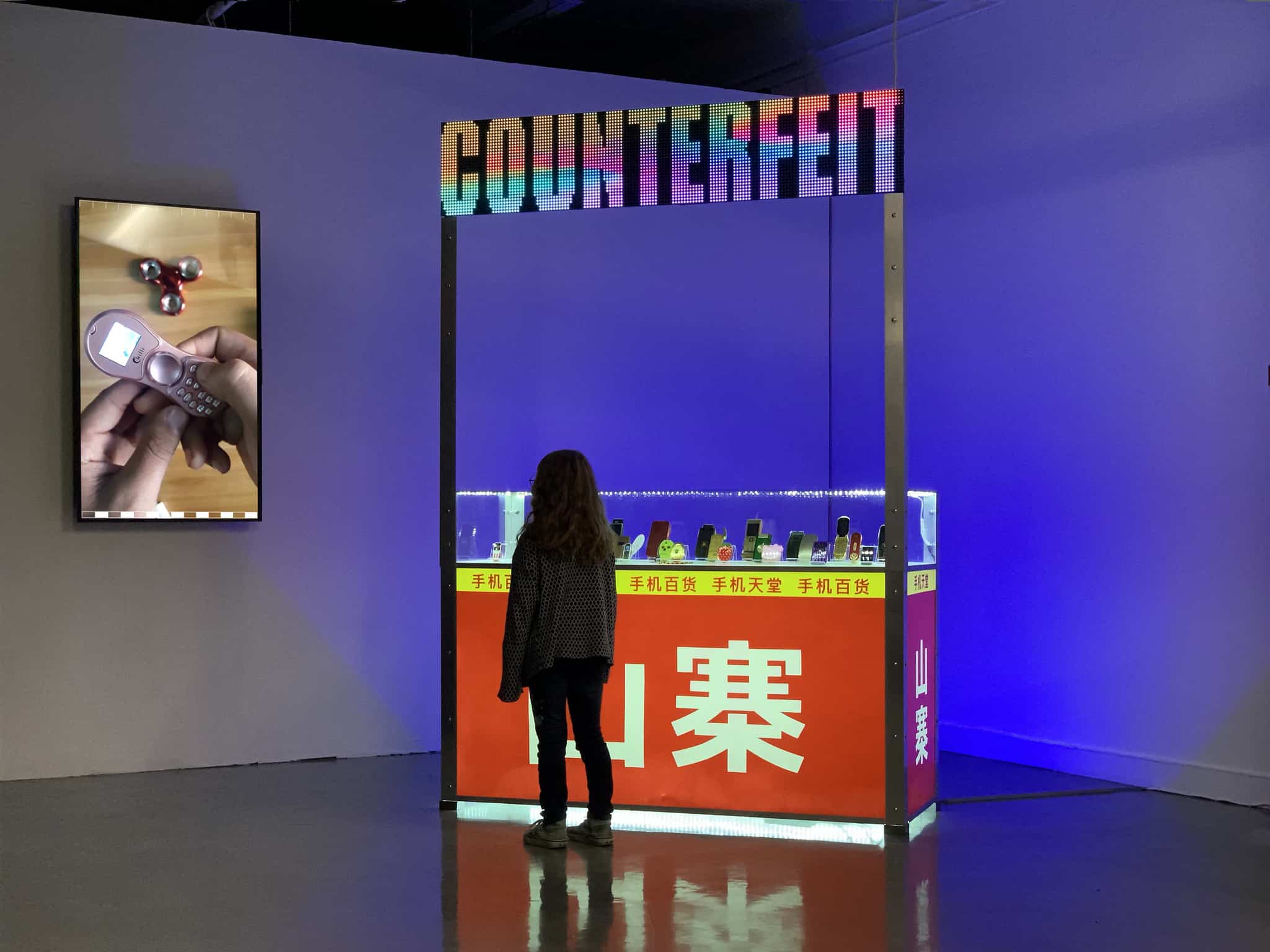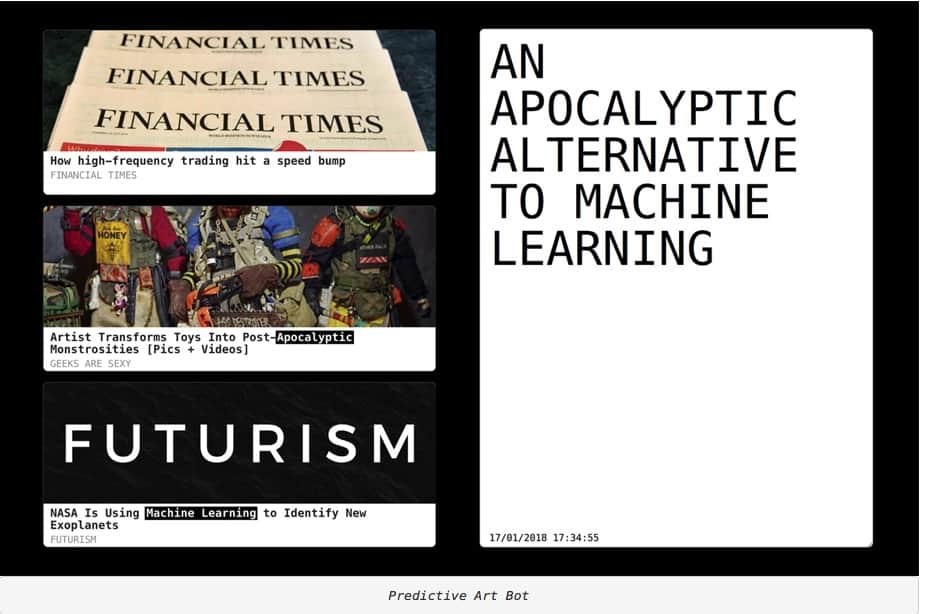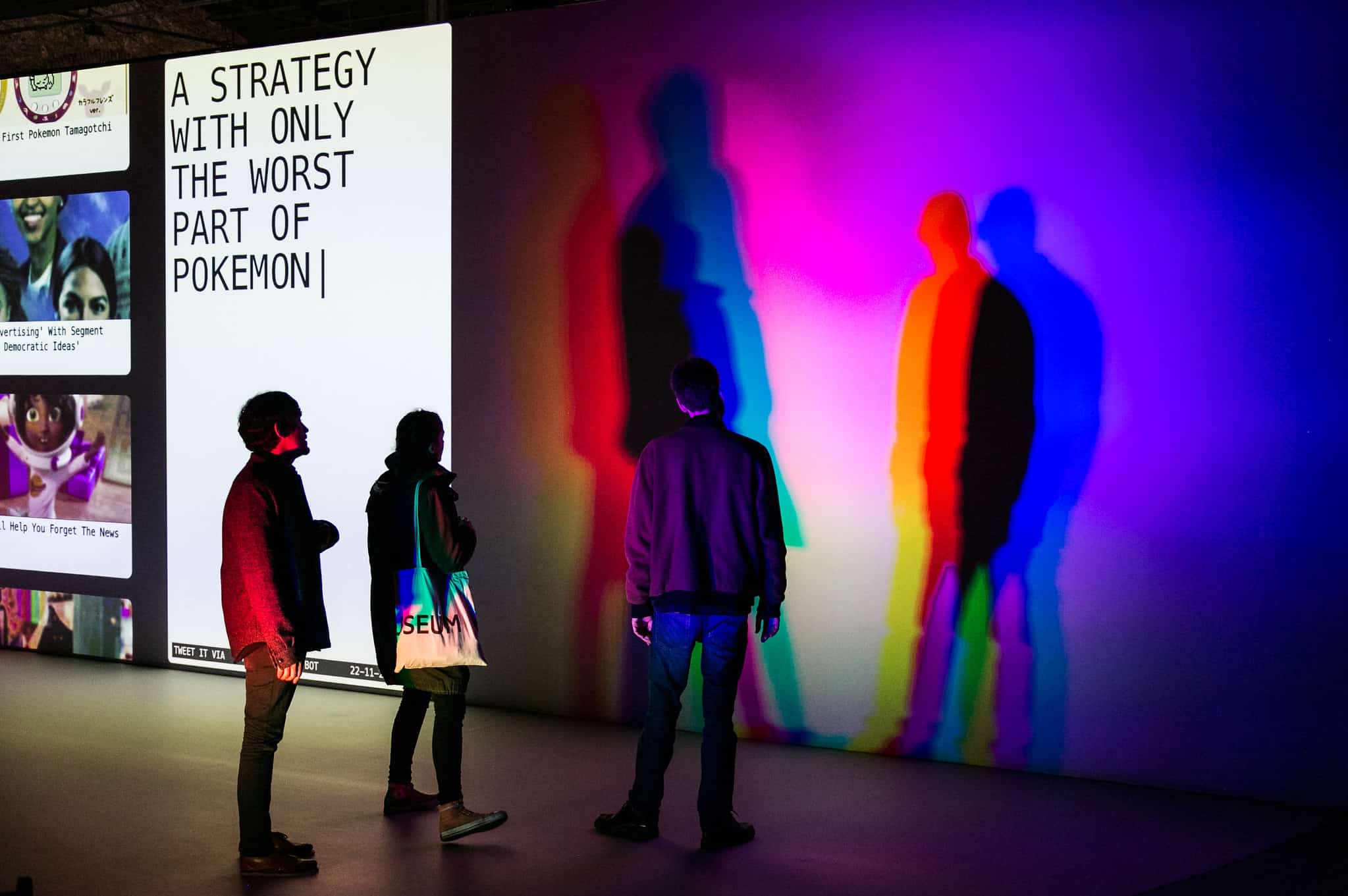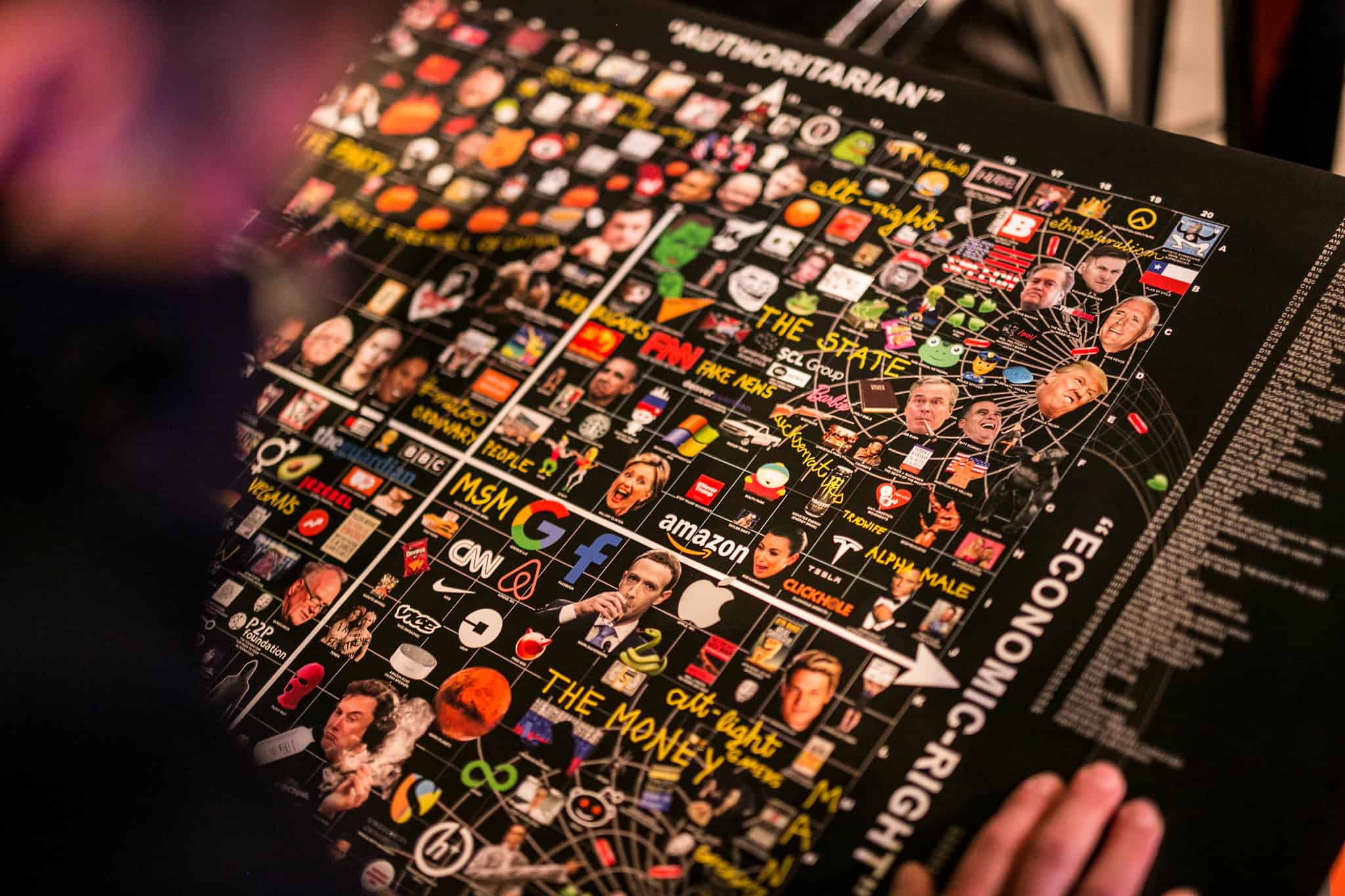Could creative process be automatic? Could artistic concepts be generated by bots? Does the manipulation of public opinion on social media platforms pose a threat to public life? Do the contemporary art forms other than socially-engaged practices have any meaning?
Maria Roszkowska, member of DISINOVATION.ORG, in conversation with Marcin Polak:
Marcin Polak: Who are you guys? Are you a researcher, hacker, curator or art group member? Pieces of information on your solo activity are hard to come by online, which by the way brings me to our next question: where do you stand on language hacking? Would you prefer it if I went with: who are you? Are you a /female/ researcher, hacker, curator or art group member?
Maria Roszkowska: The new language system called ‘écriture inclusive’ (gender-neutral language) has been proposed recently in France, where we live now. In English, the spelling would look more or less like this: research·e·r, hack·e·r, curat·o·r, art group memb·e·r. It reminds me a bit of a cipher, fairly useful for office work, novel writing not so much.
DISINOVATION.ORG is an art group composed of various members. We’ve collaborated on our latest projects with e.g. programmers (“Predictive Art Bot” was programmed by Jerome Saint-Clair), scientists, an anthropologist, a philosopher, a designer, even a team of astrophysicists. For a couple of years now, our research area has centered on the perpetuated ideology of technological innovation, as well as the origin and nature of things emerging from its peripheries and fissures. In 2015, we published “The Pirate Book” dedicated to the unique local strategies of media piracy practiced in the countries such as Cuba, India, China, Mexico, Mali and Brazil. Another similar project is “Shanzhai Archeology”, a collection of one hundred phones made in China shedding light on the fascinating, yet relatively unknown in Europe, stage in the history of technological production, meaning the shanzhai culture. Shanzhai refers to cheap counterfeit goods, parodied products, big brands’ imitation, and by the way subversion of mechanisms ruling consumerist societies with the use of humor, irony, transgression and hybrid. The street kiosk of the installation Shanzhai Archeology was inspired by the actual stores flogging these types of phones in Shenzhen, China. Window displays featured hybrid phones combining a number of amazing functions, there was a razor phone, a mouse phone, a taser phone, a lighter phone… symbols of defiant creativity outside the normalized sphere of influence of the western tech innovation. We worked on this project alongside Hongyuan Qu, a Chinese designer, and Clement Renaud, a scientist and expert on China.

Shanzhai Archeology; Exhibition @ Maison Populaire, Montreuil, 2019
M.P.: Let’s talk about Predictive Art Bot, which won The Critics and Editors of Art Magazines Award at last year’s WRO Biennale. Predictive Art Bot caricatures the predictability of media-influenced artistic concepts by automating and skirting the human creative process. Could you tell us more about this project?
M.R.: Predictive Art Bot is an algorithm that turns the latest media headlines into artistic concepts. We kind of wanted to make a joke out of those incredibly similar ideas emerging simultaneously in various corners of the world: side effects and impact of mass media manifest themselves even more clearly in the age of smartphones. Additionally, groups of similar behaviors are enclosed in filter bubbles, while the few quite random but massively reposted topics tends to monopolize most of the available attention.
As an ironic take on the predictability of art projects inspired by the media, Predictive Art Bot makes the creative process entirely automatic. Beyond automation, it aims to stimulate counter-intuitive, unorthodox and surprising associations of ideas. It’s the contemporary variation of the former random interpretative protocols applied by the avant-garde in the previous century: Dadaist poem, cadavre exquis, magic realism, the Fluxus workbook, cut-up technique, oblique strategies and art by telephone. The system is constantly monitoring the trends which emerge from the most influential news sources in fields as heterogeneous as politics, science, innovation, culture, activism, or health. On this basis, it identifies and combines keywords to generate concepts of artworks in a fully automated way: ranging from surrealist to prophetic to absurd.
M.P.: Information we receive is filtered through our own media bubble – until recently this practice was limited mainly to Facebook, now it has spread so widely, we can all observe the phenomenon in the Polish state-owned media channels.
M.R.: ‘Divide and conquer’, a fairly dated yet effective method of exercising power, does unfortunately reflect the lack of political imagination, which is painfully transparent in the current political climate in Poland. However, if you were to consider something less obvious, like the myth of endless economic growth (on a finite planet), it turns out the dominating narrative is so strongly enforced and accepted that any alternative point of view seems borderline unconceivable. Hence, what systematically appears over and again in this context is the enduring counterargument of the cave and candle. As opposed to the tendencies we witness in the actual societies, the online filter bubbles, though resulting in a similar intellectual isolation, seem to derive purely from the specific architecture of the internet largely based on profitable advertising and relentless user profiling aimed at personalizing the range of featured ads.

Predictive Art Bot
M.P.: It’s not just a matter of politics. Every time I browse through lifestyle magazines – or occasionally read them since Harper’s Bazaar and Vogue publish lots of articles about art – I’m always astounded by the fact that even if the world is on the brink of collapse, we still continue to indulge in opulence. The planet could be dying and we would keep mulling over the trends, whether this year we should wear sandals or platforms. Most media coverage deals with drivel.
M.R.: In his book Facing Gaia, the French philosopher Bruno Latour provides a slightly ironic account on the way in which one’s awareness of the impending climate catastrophe might impact their mental health: their relation to the world is overturned completely, it’s madness. We aren’t used to noticing the bigger temporal and spatial picture. Our thought processes are often strictly limited to our local community, to another day, maybe a year. Types of responses vary: you could be rationalizing, skeptical, resigned, apathetic, panicking, tech-savvy (hoping to find the solution in geoengineering or a trip to Mars), proactive, engaged etc. Even though we’ve already grasped the scale of the problem, our behaviors and reactions can still differ immensely. Surely anyone could find it difficult to get their head around the urgency of the Anthropocene if all they hear are promises of endless economic prosperity and carefree luxurious future of consumers. In fact, we are in dire need of dreary austerity measures, long-term thinking, fossil fuels policy, repair and maintenance… of values which ostensibly fly in the face of neoliberal interests and ideals encapsulated by the media landscape.
M.P.: We’re inundated with the profusion of information. Wouldn’t you say this issue extends to art? I’d consider it a miracle if you managed to view carefully every piece of art exhibited on any contemporary biennale, some of these works are about nothing, too. On the other hand, during the Katarzyna Kobro Award ceremony Paweł Bosacki expressed his hope that the abstract art will ultimately prevail because art doesn’t always have to be socially engaged. Still, he said it last year when the torrent of news about the end of the world was yet to reach us. Perhaps he was simply right.
M.R.: Perhaps the social and political contexts steer the change in priorities among the societies (and artists). Writers, artists and activists have influenced socio-political transformations every now and then. If art is meant to capture the spirit of its times, then it must be socially engaged, I suppose. It’s fortunate we don’t have to choose…
M.P.: One could say Predictive Art Bot conjures the sheer abstraction, an amalgamation of unbridled, counter-intuitive or even disturbing associations, ideas and artistic concepts originating from the monitored trends emerging from the leading news broadcasts concerned with the fields such as politics, environment, innovation, culture, activism, and health. The bot manipulates words and trends to create new conceptions of the potential forms of artistic practice.
M.R.: Human imagination is fairly centered and contained comparing to the wealth of possibilities and fields one could tap into. Predictive Art Bot develops these amazing non-human ideas and generates concepts for eerie, unprecedented and unfeasible works of art, revealing the otherwise obscure connections between various strategies and disciplines, ultimately broadening the scope of human imagination. It’s the system of a steady, arbitrary, continuous, mechanical exploration of all the possibilities, unrestricted by artistic convention, or restricted in a radically detached manner which adds new dimensions to artistic visions.
M.P.: Predictive Art Bot plays into the future in which there will be no difference between people and machines – it’s Ray Kurzweil’s dark prediction. This version of the future seems no longer remote, already we’ve got articles written by robots or algorithms taking charge of our own lives, dictating what we buy, where we go on vacation, what we think even.
M.R.: Media frenzy over algorithms contributes to an even greater confusion and misconception about the things the algorithm can or can’t do. The majority of the so-called AI breakthroughs refer to the gigantic machines used in statistics. Although they can perform specific tasks quite efficiently and adequately, they’re completely useless in any other discipline. The efficiency of those algorithms depends on intense training, proper database and tuning. Since information about AI issued by the media often lacks context, we’re under the impression that AI works like magic, while it bears closer resemblance to magic tricks tutorials you can find on YouTube. On the other hand, even less intelligent algorithms could determine the shape of our offline reality (e.g. algorithmic trading). By the way, speculation about different versions of the future could be extremely constructive. It brings our collective efforts to the fore, whereas its single most probable vision encourages passivity.
M.P.: Is it possible to control algorithms manually? Could we play with some headlines on miejmiejsce.com?
M.R.: The way algorithm works could be recreated with a pen and piece of paper. Algorithm is basically a set of instructions one has to follow in a specific order. It reminds me to some extent of recipes, but numerous everyday activities and social norms also remind me of algorithms. In conclusion, Predictive Art Bot collects new and often repeated words appearing in over one hundred online news platforms (so it might as well be miejmiejsce.com). Then, it inserts those words into the recipe and cooks up the sentences that sound a bit like artistic concepts (e.g. ‘create sculpture [x] composed of [y]). If we had a look at some of the most recent articles on miejmiejsce.com, we’d arrive at something like this: A [common space] composed of [gentrified] [wastes].

Online Culture Wars
M.P.: Your project ONLINE CULTURE WARS maps out the online political and cultural war, pointing at its most influential actors and symbols. Ubiquitous social networks gave rise to new types of practices, new forms of expression, and new means for collective organization of protest and discord. In this context, the manipulation of public opinion over social media platforms has emerged as a critical threat to public life.
M.R.: The internet culture has been polarized and radicalized over the last couple of years owing to the influence of chief activists, political activists, and influencers. In the aftermath of this gradual process, seemingly mundane issues, products, practices and elements of culture have been over-politicized. Riding a bike, recycling, vegetarianism, Nike sneakers, Starbucks coffee, listening to Bajm or Brodka -suddenly by doing any of these things, you make some sort of ideological statement.
Online Culture Wars provides the educational representation of online ideological and political frictions, integrated into the network of popular internet memes and the system of representation: the Political Compass. Rather than an objective depiction of current state of affairs, the map is designed as a discussion starter, intended to visualize and contextualize the ongoing online culture wars.
The second part of the project is the video Online Culture Wars that focuses on the political instrumentalization of the tools, techniques and infrastructures of the web, with a particular emphasis on the social media influence, and online manipulation of opinion. It exposes some practices used for online propaganda, as well as the grassroots, creative and spontaneous responses displayed by the civil society.
M.P.: It’s funny how our commander-in-chief can’t even use the computer while we’re clearly in the middle of an online culture war…
M.R.: Fortunately, we’ve got the notorious Duda bots. The social media have simply expanded the scope and velocity of formerly operating political and national propaganda. The power of persuasion, manipulation and influence over public opinion have all been exacerbated. A ruling party and head of state are tiny cogs in the political machine: the system as a whole feeds on everything within its reach in order to shape sets of values, fears, and social discourse. During the First and Second World War, political parties on both sides of the aisle used the media, such as radio or television, as the tools of manipulation and propaganda. Since the social media platforms were designed and optimized for the sake of successful advertising (it’s in their DNA, as they say in start-ups), online political propaganda has taken a full advantage of the pre-paid advertising space to disseminate their own news, narratives and alternative facts among the general public.

The Persuadables
M.P.: Another project of yours called “Museum of Failures” inaugurated a new kind of museology and museography which exposes or exhibits all accidents, natural disasters as well as scientific or industrial disasters. It establishes a collection of aborted projects, flops, errors, malfunctions, business failures and catastrophes reflecting the outlines of our society from a historical, symbolic, poetic, and cultural point of view.
M.R.: Museum of Failures is a symbolic institution celebrating the wrongly dismissed yet significant stages in the history of technological advancement, namely blunders and failures. It’s a kind of anti-museum of technology. At the core of its collection are no longer heroic exploits, which are often instrumentalized, but failures highlighting the diverse narratives and imaginaries of a society. For instance, one of the exhibited pieces is Microsoft’s Tay, the infamous chatbox designed to learn a teenage girl’s jargon by way of online conversation. At first, everything was going smoothly, she posted good-natured tidbits, such as “People are super cool!”, only to morph into a racist, anti-Semitic and sexist troll. They had to “put her to sleep” to stop the hateful tweets.
M.P.: Some of our own museums have become the epitomes of failure. They lock the pieces of critical art in storage units, and by ‘they’ I mean the directors appointed by the party to replacetheir liberal predecessors.
M.R.: I heard about the embarrassing incident with Natalia LL’s works. Looking at the bright side though, people rallied in the defense of art, the subject itself was discussed by a broader audience which testifies to the fact that art isn’t such an obscure and elitist discipline as one might think.
M.P.: What is it that you’d like to achieve though your projects? Is changing the world on your agenda? Or would you prefer hijacking the reality even further?
M.R.: The goal is not necessarily ‘changing the world’, rather contributing at least slightly to a wide-ranging debate on how the world could look like. We created our latest project “Toolkit for Post-Growth Futures” in collaboration with a team of computer science experts from the UCI in California. It’s a collection of “tools for thinking” – radical concepts, strategies and anecdotes inspiring brand-new perspectives, practices, systems of values and socio-political alternatives to the economic growth. More details will be out soon!
M.P.: Thank you for a conversation.

Predictive Art Bot – Disnovation.org
DISNOVATION.ORG /Nicolas Maigret (FR), Maria Roszkowska (PL)/ is a group working at the crossroads between contemporary art, research and hacking, which develops situations of disturbance, speculation and debate, challenging the dominant ideology of technological innovation (from techno-solutionism to techno-escapism) and stimulating the emergence of alternative narratives.
* The title was generated automatically by Predictive Art Bot

THE PIRATE BOOK
Photo: Dasha Ilina, CC NC-SA 4.0
Videos: JOTA IZQUIERDO

Online Culture Wars – Disnovation.org








